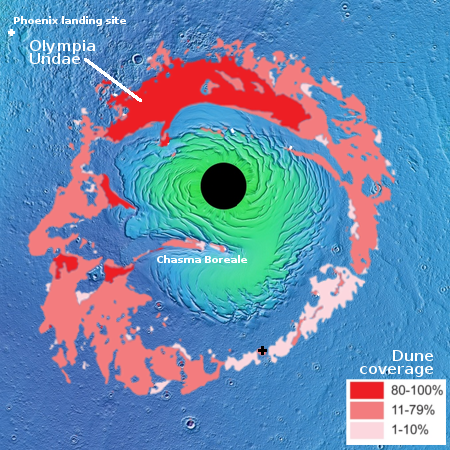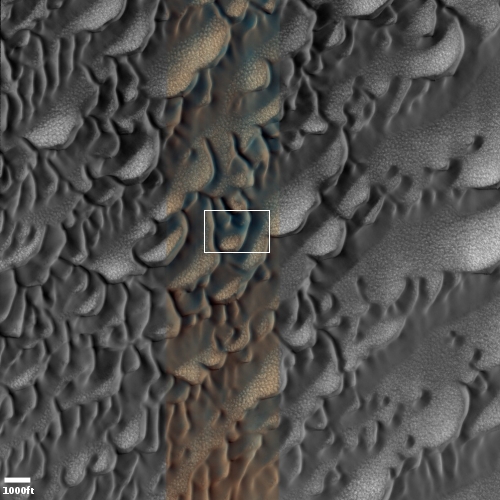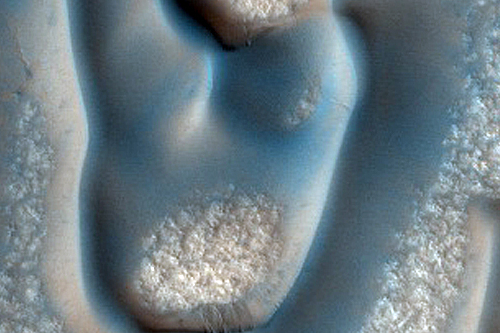Snow on Martian dunes
Cool image time! The first photo to the right, rotated, cropped, and reduced to post here, was taken on September 19, 2021 by the high resolution camera on Mars Reconnaissance Orbiter (MRO), and shows what appears to be snow nestled in the hollows of many dunes.
The second photo, cropped to post here, shows in high resolution the area in the white box.
Is that snow water, or dry ice? The location is very far north, 76 degrees latitude, so it could be either. Since the photo was requested by Candice Hansen of the Planetary Science Institute in Arizona, I emailed her to ask. Her answer:
Early in the spring all the bright stuff is dry ice. As it gets later in the spring it is probably still mostly dry ice but with HiRISE images alone we cannot really distinguish the composition of the ice. In-between the dunes it is almost certainly bare ground late in the spring, but since the dunes are dark the surface just looks bright in contrast
This picture was taken in summer, which suggests the snow is probably water, not dry ice. Yet, all the snow is found in the north-facing hollows, places that will remain mostly in shadow at this high latitude, 76 degrees north. Thus, it is possible that the snow is the last remaining traces of the thin dry ice mantle that covers the Martian poles down to about 60 degrees latitude during the winter, and sublimates away in summer.
Hansen had requested a whole bunch of similar images of such snowy dunes. As she explained,
The reason for this image set is that the ice (whatever kind it is) persists much later into the summer than at other locations. So we are curious about that… Certainly it stays in what we call “cold traps” longer – that would be the spots getting less sunshine so you are right about the north-facing slopes.

The black cross south of the north pole ice cap in the overview map to the right marks the location of these dunes. The location is inside the giant dune sea that encircles the northern ice cap. At this location, dunes cover about half the surface.
Why such a dune sea exists in the north but not in the Martian south pole is not presently understood. Nor is it clearly understood why the sea exists at all. Probably, a partial explanation lies in the fact that the north pole is in the northern lowland plains and the south pole is in the cratered highlands. The smoother northern plains might allow dust to accumulate more easily in the north, aligning with polar jet streams. In the south the craters and rougher terrains might block that accumulation.
This theory however is a guess, based on very superficial knowledge.
On Christmas Eve 1968 three Americans became the first humans to visit another world. What they did to celebrate was unexpected and profound, and will be remembered throughout all human history. Genesis: the Story of Apollo 8, Robert Zimmerman's classic history of humanity's first journey to another world, tells that story, and it is now available as both an ebook and an audiobook, both with a foreword by Valerie Anders and a new introduction by Robert Zimmerman.
The print edition can be purchased at Amazon or from any other book seller. If you want an autographed copy the price is $60 for the hardback and $45 for the paperback, plus $8 shipping for each. Go here for purchasing details. The ebook is available everywhere for $5.99 (before discount) at amazon, or direct from my ebook publisher, ebookit. If you buy it from ebookit you don't support the big tech companies and the author gets a bigger cut much sooner.
The audiobook is also available at all these vendors, and is also free with a 30-day trial membership to Audible.
"Not simply about one mission, [Genesis] is also the history of America's quest for the moon... Zimmerman has done a masterful job of tying disparate events together into a solid account of one of America's greatest human triumphs."--San Antonio Express-News
Cool image time! The first photo to the right, rotated, cropped, and reduced to post here, was taken on September 19, 2021 by the high resolution camera on Mars Reconnaissance Orbiter (MRO), and shows what appears to be snow nestled in the hollows of many dunes.
The second photo, cropped to post here, shows in high resolution the area in the white box.
Is that snow water, or dry ice? The location is very far north, 76 degrees latitude, so it could be either. Since the photo was requested by Candice Hansen of the Planetary Science Institute in Arizona, I emailed her to ask. Her answer:
Early in the spring all the bright stuff is dry ice. As it gets later in the spring it is probably still mostly dry ice but with HiRISE images alone we cannot really distinguish the composition of the ice. In-between the dunes it is almost certainly bare ground late in the spring, but since the dunes are dark the surface just looks bright in contrast
This picture was taken in summer, which suggests the snow is probably water, not dry ice. Yet, all the snow is found in the north-facing hollows, places that will remain mostly in shadow at this high latitude, 76 degrees north. Thus, it is possible that the snow is the last remaining traces of the thin dry ice mantle that covers the Martian poles down to about 60 degrees latitude during the winter, and sublimates away in summer.
Hansen had requested a whole bunch of similar images of such snowy dunes. As she explained,
The reason for this image set is that the ice (whatever kind it is) persists much later into the summer than at other locations. So we are curious about that… Certainly it stays in what we call “cold traps” longer – that would be the spots getting less sunshine so you are right about the north-facing slopes.

The black cross south of the north pole ice cap in the overview map to the right marks the location of these dunes. The location is inside the giant dune sea that encircles the northern ice cap. At this location, dunes cover about half the surface.
Why such a dune sea exists in the north but not in the Martian south pole is not presently understood. Nor is it clearly understood why the sea exists at all. Probably, a partial explanation lies in the fact that the north pole is in the northern lowland plains and the south pole is in the cratered highlands. The smoother northern plains might allow dust to accumulate more easily in the north, aligning with polar jet streams. In the south the craters and rougher terrains might block that accumulation.
This theory however is a guess, based on very superficial knowledge.
On Christmas Eve 1968 three Americans became the first humans to visit another world. What they did to celebrate was unexpected and profound, and will be remembered throughout all human history. Genesis: the Story of Apollo 8, Robert Zimmerman's classic history of humanity's first journey to another world, tells that story, and it is now available as both an ebook and an audiobook, both with a foreword by Valerie Anders and a new introduction by Robert Zimmerman.
The print edition can be purchased at Amazon or from any other book seller. If you want an autographed copy the price is $60 for the hardback and $45 for the paperback, plus $8 shipping for each. Go here for purchasing details. The ebook is available everywhere for $5.99 (before discount) at amazon, or direct from my ebook publisher, ebookit. If you buy it from ebookit you don't support the big tech companies and the author gets a bigger cut much sooner.
The audiobook is also available at all these vendors, and is also free with a 30-day trial membership to Audible.
"Not simply about one mission, [Genesis] is also the history of America's quest for the moon... Zimmerman has done a masterful job of tying disparate events together into a solid account of one of America's greatest human triumphs."--San Antonio Express-News




Kool !!!
“The Donner Party begin their ill-fated journey to California…”
May 12, 1846
https://youtu.be/1KsKJHX50PE
2:56